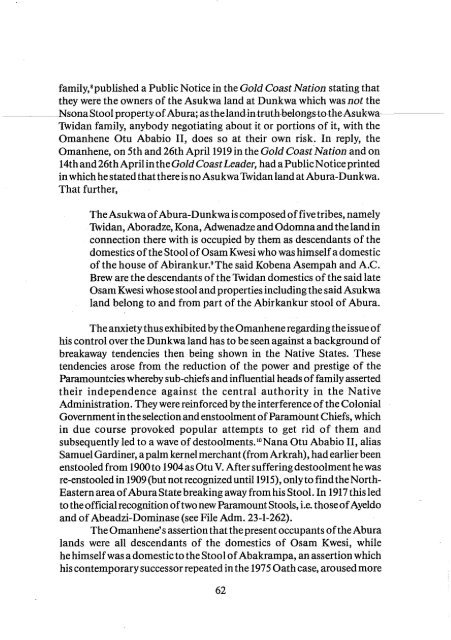You also want an ePaper? Increase the reach of your titles
YUMPU automatically turns print PDFs into web optimized ePapers that Google loves.
family, Bpublished a Public Notice in the Gold Coast Nation stating that<br />
they were the owners of the Asukwa land at Dunkwa which was not the<br />
Nsona Stool property of Abura;astheland-intruthbelongstotheAsukwa<br />
1\vidan family, anybody negotiating about it or portions of it, with the<br />
Omanhene Otu Ababio II, does so at their own risk. In reply, the<br />
Omanhene, on 5th and 26th April 1919 in the Gold Coast Nation and on<br />
14th and 26th April in the Gold Coast Leader, had a Public Notice printed<br />
in which he stated that there is no Asukwa Twidan land at Abura-Dunkwa.<br />
That further,<br />
The Asukwa of Abura-Dunkwa is composed offive tribes, namely<br />
1\vidan, Aboradze, Kona, Adwenadze and Odomna and the land in<br />
connection there with is occupied by them as descendants of the<br />
domestics of the Stool of Osam K wesi who was himself a domestic<br />
of the house of Abirankur. 9 The said Kobena Asempah and A.C.<br />
Brew are the descendants of the Twidan domestics of the said late<br />
Osam Kwesi whose stool and properties including the said Asukwa<br />
land belong to and from part of the Abirkankur stool of Abura.<br />
The anxiety thus exhibited by the Omanhene regarding the issue of<br />
his control over the Dunkwa land has to be seen against a background of<br />
breakaway tendencies then being shown in the Native States. These<br />
tendencies arose from the reduction of the power and prestige of the<br />
Paramountcies whereby sub-chiefs and influential heads of family asserted<br />
their independence against the central authority in the Native<br />
Administration. They were reinforced by the interference of the Colonial<br />
Government in the selection and enstoolment of Paramount Chiefs, which<br />
in due course provoked popular attempts to get rid of them and<br />
subsequently led to a wave of destoolments. IO Nana Otu Ababio II, alias<br />
Samuel Gardiner, a palm kernel merchant (from Arkrah), had earlier been<br />
enstooled from 1900 to 1904 as Otu V. After suffering destoolment he was<br />
re-enstooled in 1909 (but not recognized until 1915), only to find the North<br />
Eastern area of Abura State breaking away from his Stool. In 1917 this led<br />
to the official recognition oftwo new Paramount Stools, i.e. those of Ayeldo<br />
and of Abeadzi-Dominase (see File Adm. 23-1-262).<br />
The Omanhene' s assertion that the present occupants of the Abura<br />
lands were all descendants of the domestics of Osam Kwesi, while<br />
he himself was a domestic to the Stool of Abakrampa, an assertion which<br />
his contemporary successor repeated in the 1975 Oath case, aroused more<br />
62
















